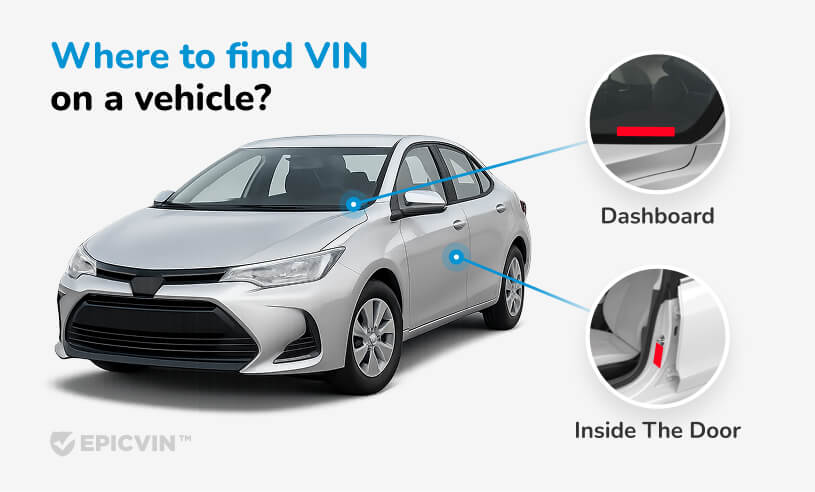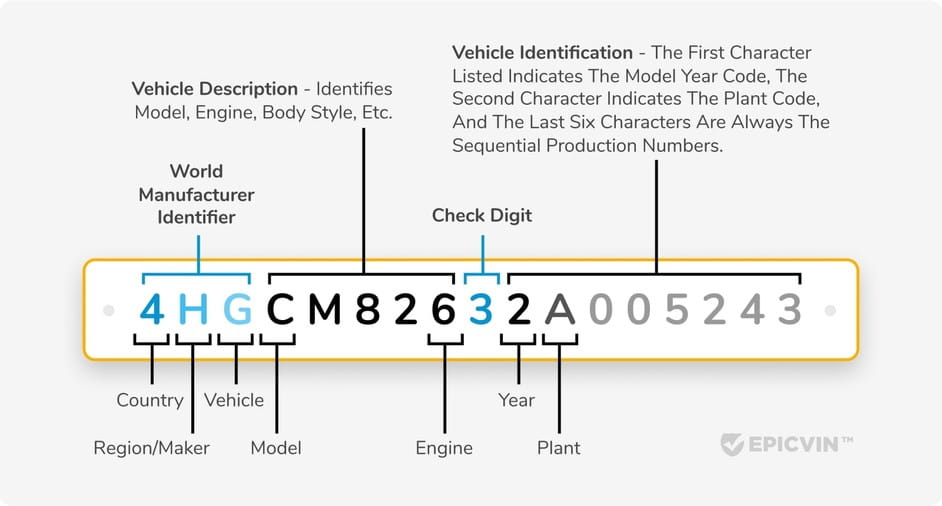
How to Read a VIN Number Like a Pro
From understanding the VIN number breakdown to uncovering a vehicle’s history,...

Free Honda VIN Decoder! 🚗 See specs, build sheet, recalls basic history—no sign-up. 🛡️✅ Need accidents, mileage, title? Upgrade in one click.
Looking for the VIN?
Here is there you’ll find it:

A Honda vehicle identification number (VIN) is a unique 17-character identifier. It reveals your vehicle's factory specifications and hidden history. Using our free VIN decoder helps you make informed decisions about your transportation investment. Note that users are unable to access full historical data without upgrading to the premium report. However, basic security verification remains free.
Follow these steps to obtain complete vehicle details:

Your Honda's vehicle identification number appears in several standard locations. Common spots include:
| Metric | What it Means |
|---|---|
| Vehicles with accident history – 34% | EpicVIN's audit of ≈ 1.2 million Honda reports shows one in three cars carries at least one crash/damage record. |
| Flood/water titles | Post-2024 storm tracking indicates ≈ 347,000 flood-damaged vehicles have been re-registered nationwide. Many are now listed far from the disaster zones. |
| Typical annual mileage – ≈ 11,700 mi | Registration and odometer data reveal the Accord averages ≈ 11.7k mi per year in its first decade. So, a six-year-old Honda with ~70k mi is right on target. |
| Largest active campaign (2025) | Campaign 23V-158 (seat-belt buckle) affects 448,613 Accord, CR-V, Odyssey, RDX, and other models; a quick VIN check confirms whether repairs are complete. |
| Problem | Scope & Details |
|---|---|
| Fuel-pump failure | Dec 2023—Recall 23V-858 pulled 2,539,902 2017-2020 Honda/Acura models (Accord, CR-V, Civic, etc.). A deformed impeller can stall the engine; dealers replace the pump module free. |
| CVT belt wear/shudder | Service bulletin 21-047 extends CVT coverage on ~445,000 HR-V 2016-2020. Slipping or vibration often appears past 60k mi. |
| Oil dilution (1.5 T) | Wards reports ~400k CR-V 2017-18 and ~517k Civic 2016-18 with the 1.5-liter turbo can suffer fuel-in-oil in cold climates. Campaigns 18-114/124 flash the ECU and change oil. |
Tip: Before purchasing a used Honda, run the VIN number through EpicVIN — the report will show whether the car falls under these mass campaigns or hides expensive repairs.

Each character in your vehicle's unique sequence tells a specific story. Here's the standard VIN format:
Here's how our Honda VIN decoder works (a sample VIN – 5FNYF7H5XMB007135):
| Symbols | Sample | What It Reveals |
|---|---|---|
| 1 | 5 | The United States as the country of origin |
| 2 | F | Honda as a manufacturer |
| 3 | N | Passenger car vehicle type |
| 4-8 | YF7H5 | Sedan body style, engine type, restraint system, Pilot model line, and trim level |
| 9 | X | Check digit for validation |
| 10 | M | 2021 model year |
| 11 | B | Assembly plant location (Greensburg, Indiana) |
| 12-17 | 007135 | Individual vehicle serial number |
Year 2001
Make Honda
Model CR-V
Fuel Type Gasoline
Engine 2L In-Line B20Z2
Made in JAPAN
Our free VIN decoder reveals comprehensive vehicle details. You can obtain these key insights:
Run the VIN in EpicVIN before you buy a used Honda. In 15 seconds, you'll see factory options and hidden risks—347k flood titles from the 2024 hurricanes, 450k open seat-belt recalls, and mileage anomalies in only 3% of late-model Hondas. Those facts can save you thousands.Alex Black, CMO & auto expert, EpicVIN
Yes. EpicVIN lets you run a basic Honda VIN check at no cost—you'll see build data such as model, engine, plant, and trim. You pay only for the full history report with accidents and mileage.
Yes. Any Honda (or Acura) product with a standard vehicle identification number (VIN) can be interpreted with EpicVIN. Analyze any model, from Civic and CR-V to Gold Wing bikes and Pioneer UTVs.
Absolutely. EpicVIN checks the live NHTSA feed, so active campaigns appear instantly with a link to the official repair bulletin.
Yes. You'll get the model line, engine code, drivetrain, trim, and plant of build. For most 2010-plus vehicles, EpicVIN also shows option codes and original MSRP.
Dealers, insurers, and auction buyers rely on it because EpicVIN fuses data from NMVTIS title feeds, state-DMV records, insurance databases, auction photos, live Honda APIs, and service logs—updated daily. Our free VIN decoder tool shows current specs; you only pay for the full history report.
Discover expert tips, news and advice on buying and maintaining used vehicles

From understanding the VIN number breakdown to uncovering a vehicle’s history,...

Learn how to find your tire size by VIN number and ensure your vehicle's safet...

A vast selection of all-wheel-drive sedans available at a wide range of pricin...